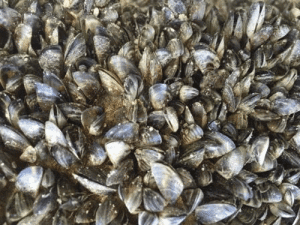
Zebra Mussels are one of the most problematic invasive species in Texas.
How can an innocent clam, bee, or tree bring down an entire ecosystem? If they’re an invasive species, its easier than you might think.
An invasive species is a plant, animal, or even fungus that has been introduced to an area where it doesn’t belong and is causing harm because of it. There are plenty of examples of invasive species in Texas, from the feral hogs in our forests to the red fire ants in our prairies. These species can cause damage to our ecosystems, economy, agriculture, and health.
Invasive species don’t mean to invade- they’re just animals and plants who have been brought to a new place and are trying to survive. The problem is that they don’t face any of the same population-controlling threats that they would in their native habitats. Where at home they might have natural predators, disease, or other limiting factors, here they face no such threats and their populations spiral out of control, wreaking havoc as they go.
Not all non-native species are considered invasive. Tomatoes, for example, are native to South America but were brought here as crops, making them non-native to North America. In order for a species to be considered “invasive” it has to be non-native, cause harm, and thrive in this new environment. So, while tomatoes aren’t necessarily meant to be here, they aren’t going to spread all over your yard, killing the other plants in their path, eventually taking over the entire neighborhood.
An invasive plant like Japanese Privet, however, might do just that. It was brought from Asia to America as an ornamental plant for someone’s lawn and unfortunately spread like wildfire. Once introduced to an area, this shrub forms dense thickets, shading and out-competing many native species. It colonizes rapidly, spreading throughout an area, killing the native plants that insects and birds depend on. Before you know it, what was once a bustling forest full of native plants and animals is now just a graveyard of privet.
Invasive species destroy ecosystems by out-competing native species for resources. They destroy economies and agriculture in much the same way. The Africanized Honey Bee, for example, will out-compete native bees for flowers and hives. Africanized Bees are unreliable honey-makers and pollinators, so bee keepers, honey distributors, and farmers that depend on natural pollination all take a hit when they invade. Industries built on native plants and animals can suffer greatly when invasive species are introduced.
Once an invasive species has arrived in a place and started to flourish, it can be incredibly difficult to eradicate or even manage. Zebra Mussels, for example, have cost the U.S. countless hours, resources and dollars as we try to prevent them from spreading, but their populations are still on the rise. It goes without saying that the best way to keep an invasive species from invading is to never introduce them in the first place.
You can do your part to prevent the spreading of invasive species. If you’re planting new flowers in your yard this spring, why not plant native species? Boost your local ecosystems and economy by removing invasive plant species from your yard and replacing them with the ones that can actually support wildlife! And we don’t expect you’ll be bringing a jar of bees over from Africa, but you can those pet cats, pythons, and parakeets inside and away from native species. Together, we can stop the spread of invasive species!
